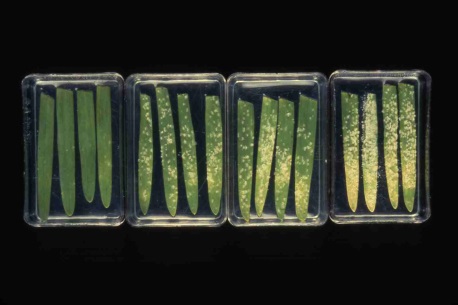Elicitors and biostimulants are both important tools for improving plant health and resilience. Elicitors are a specific type of biostimulant that activate the plant’s natural defence responses by mimicking the presence of pests or pathogens. While not all biostimulants function as elicitors, many do possess elicitor-like properties, meaning they can enhance both plant growth and defence simultaneously. This dual function makes them especially valuable in integrated crop protection strategies aimed at reducing chemical inputs and improving sustainability.

Resistance elicitors function by mimicking the presence of a pest, parasite, or pathogen, triggering the plant’s innate defence mechanisms, or “priming” them for attack. While this can result in a strong defensive response, full activation of these systems is metabolically costly, often leading to trade-offs in yield or quality. However, priming the defence response mechanisms so that they respond much faster to subsequent challenge by a real pathogen or pest is less costly and can enhance resistance considerably when needed.
Despite the potential of elicitors, there are relatively few elicitor-based products commercially available although several plant health products can confer partial disease resistance, often by activating the plant’s own defences rather than directly inhibiting pathogens. These substances can be grouped based on their mode of action: signalling mimics (e.g., jasmonate, salicylate, BABA, INA, BTH), pathogen-associated molecular pattern (PAMP) mimics (e.g., chitosan, bacterial extracts), volatile organic compounds (e.g., nonanol, limonene, linalool), and plant extracts (e.g., Datura metel, Ascophyllum nodosum, Vitrex neaundo, Reynoutria sachalinensis, Zummu spp.).
The efficacy of these products can be highly variable and sometimes inconsistent. One approach to improve reliability is to combine products with different modes of action. This must be done cautiously, as the molecular pathways involved in plant defence are interconnected; interactions between these pathways can lead to synergistic, neutral, or even antagonistic effects. Additionally, the effectiveness of elicitors can vary depending on the host plant species and variety, as well as on the type of pathogen. For instance, elicitors often show differing levels of success against biotrophic versus necrotrophic pathogens. In some cases, such as light leaf spot in brassica crops, elicitors can outperform conventional fungicides.
Biostimulants are another promising avenue for enhancing plant resistance, particularly microbial-based products that support plant health by stimulating plant processes such as increasing nutrient use efficiency or uptake. These beneficial microbes, often described as “plant probiotics,” can be identified through crop-agnostic discovery approaches, where candidates can be isolated from individuals of the same crop species. In addition to the direct application of microbial biostimulants, the plant microbiome can be influenced indirectly through practices such as integrated cropping systems and soil amendments, which help establish pathogen-suppressive soils and improve overall plant resilience.
With the advent of next-generation sequencing technologies, it is now possible to monitor shifts in the plant microbiome, assess the risk of emerging diseases, and identify the characteristics of healthy versus diseased microbiomes. This information can be used to guide the targeted introduction of biologicals that support plant health and resilience. When combined with traditional crop protection tools, these strategies can be integrated into IPM programmes to reduce reliance on chemical pesticides, mitigate harm to non-target organisms, and lower environmental risks.
Together, elicitors and biostimulants represent a forward-looking approach to crop protection. By enhancing plant resilience with fewer inputs and less environmental impact, they contribute to more robust and sustainable agricultural systems. When used alongside conventional pesticides within well-designed IPM frameworks, these tools offer a viable path toward reduced chemical usage, improved plant health, and greater long-term productivity.
For more information contact Lorena Rangel
References:
Yassin, M., Ton, J., Rolfe, S. A., Valentine, T. A., Cromey, M., Holden, N., & Newton, A. C. 2021. The rise, fall and resurrection of chemical‐induced resistance agents. Pest Management Science, 77(9), 3900-3909. https://doi.org/10.1002/ps.6370
